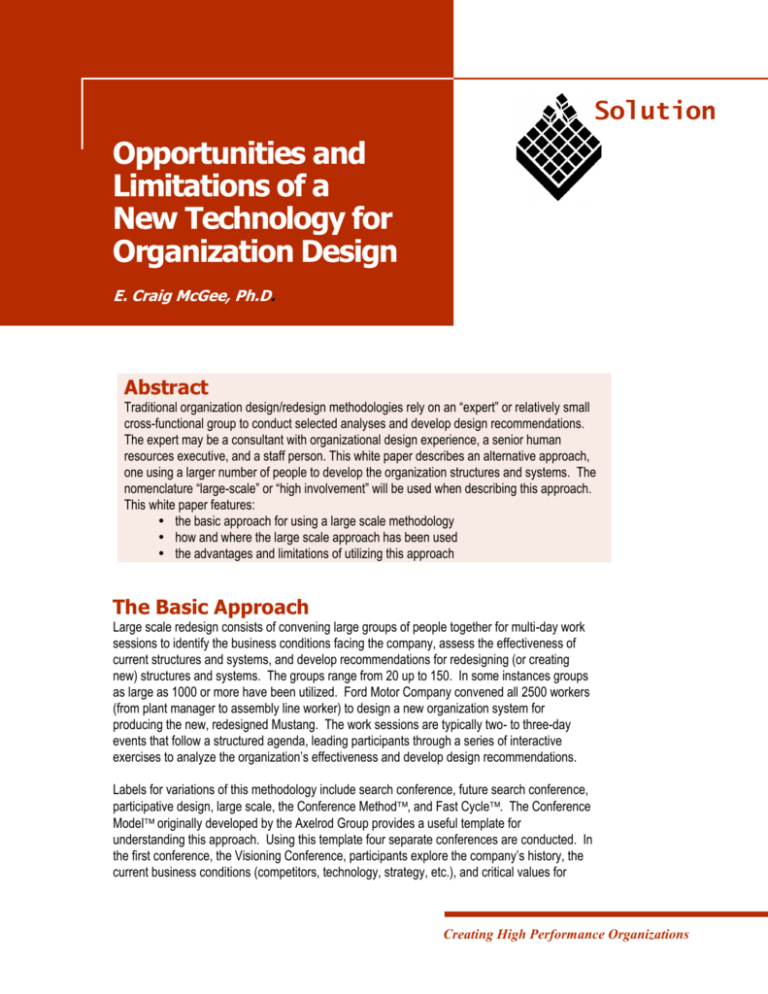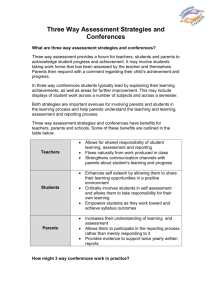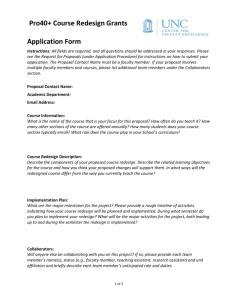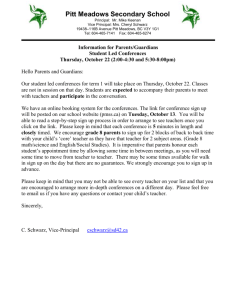
Solution
s
Opportunities and
Limitations of a
New Technology for
Organization Design
E. Craig McGee, Ph.D.
Abstract
Traditional organization design/redesign methodologies rely on an “expert” or relatively small
cross-functional group to conduct selected analyses and develop design recommendations.
The expert may be a consultant with organizational design experience, a senior human
resources executive, and a staff person. This white paper describes an alternative approach,
one using a larger number of people to develop the organization structures and systems. The
nomenclature “large-scale” or “high involvement” will be used when describing this approach.
This white paper features:
the basic approach for using a large scale methodology
how and where the large scale approach has been used
the advantages and limitations of utilizing this approach
The Basic Approach
Large scale redesign consists of convening large groups of people together for multi-day work
sessions to identify the business conditions facing the company, assess the effectiveness of
current structures and systems, and develop recommendations for redesigning (or creating
new) structures and systems. The groups range from 20 up to 150. In some instances groups
as large as 1000 or more have been utilized. Ford Motor Company convened all 2500 workers
(from plant manager to assembly line worker) to design a new organization system for
producing the new, redesigned Mustang. The work sessions are typically two- to three-day
events that follow a structured agenda, leading participants through a series of interactive
exercises to analyze the organization’s effectiveness and develop design recommendations.
Labels for variations of this methodology include search conference, future search conference,
participative design, large scale, the Conference Method, and Fast Cycle. The Conference
Model originally developed by the Axelrod Group provides a useful template for
understanding this approach. Using this template four separate conferences are conducted. In
the first conference, the Visioning Conference, participants explore the company’s history, the
current business conditions (competitors, technology, strategy, etc.), and critical values for
Creating High Performance Organizations
Opportunities and Limitations of a
New Technology for Organization Design
Solutions
success. A vision of where the company is headed and the values to guide it in that direction is
often an outcome of this conference. In the second conference, the Customer Conference,
participants explore customer requirements. They identify critical customers and what their
requirements are. Actual customers may attend the conference to provide some of this
information. In the third conference, the Technical Conference, participants document the
current business processes and determine major problems with the current work system. They
explore how the organization responds to these problems.
Up until this point, no actual redesign work has been done. Participants in the conferences
have generated data on which to base the new design. In the fourth conference, the Redesign
Conference, participants synthesize this data and develop design recommendations. Design
recommendations include both structural recommendations (how and where you draw “the
boxes” on the organization chart) as well as recommending how to change organizational
systems (rewards, training, career movement, etc.) to align with the new design.
Additional conferences may be conducted. For example, Implementation Conferences may be
designed to take the preliminary design and develop the fine detail of the new design. This
level of detail may include detailed job descriptions, operating procedures, metrics, etceteras.
To plan and execute this process, a planning team is formed. The planning team is a crossfunctional group of employees whose function is to:
design the agendas for the work sessions/ conferences
determine the numbers and types of people to invite
manage all the logistics (locations, dates, times, etc.)
manage data collection and distribution of information/results from the work sessions
A consultant experienced in large scale methodology works with the planning team. He/she
facilitates the planning team to accomplish these tasks, providing expert advice and sample
materials as needed.
Using the Conference Model template, the conferences are held 4 - 6 weeks apart.
Approximately sixty people attend the conferences with some overlap from conference to
conference to maintain continuity. Between the conferences, the planning team communicates
the outcomes of the conferences to the rest of the organization. During these communications
sessions, they also solicit feedback from people who were not at the conference. This
information is additional data to consider at the Redesign Conference when formulating the new
design.
There is substantial variability among the different approaches. Search and future search
conferences tend to focus more on identifying trends in the external environment, creating a
future vision and identifying those values for achieving that vision. Participative design tends to
focus more on creating the actual work systems for a team, department, or business unit.
2
Creating High Performance Organizations
Opportunities and Limitations of a
New Technology for Organization Design
Solutions
However, with some prudence, the different methodologies and their respective areas of
emphasis can be blended somewhat eclectically to develop a custom designed process that
best suits the client organization’s needs and resources.
Where has this approach been used?
United Airlinesi utilized this approach when establishing a new maintenance facility in
Indianapolis, IN. Employees and managers convened during a series of work sessions to
identify the values they wanted to created in the new facility and the work systems they wanted
to create. As new employees were hired, they were integrated into the work design process.
The facility started up on-time and on-budget.
Bank of Americaii utilized this methodology when installing a new computer system. A series of
conferences were held to design a new business process enabled by the new computer system
and a new organization structure to take fullest advantage of the technology. Three
conferences were conducted with approximately 100 people attending each conference.
At a software development companyiii, this methodology was utilized to clarify critical
organizational values that had propelled the company from a small, entrepreneurial startup to a
$80M business unit of an multi-billion dollar international company. The large scale process
brought all 250 people together during a two day event to identify those values that have been
responsible for their past success and what values were needed to sustain their success in a
new business context. Strategies for future growth and sustaining a high performance culture
were developed by all employees, not just a select group of senior executives.
Advantages
There are some significant advantages to be derived from utilizing a large scale, high
involvement approach. First, since large numbers of people who will be impacted by the
organizational changes are directly involved in the design of those changes, resistance to
change is substantially reduced. “People support that which they help create.” That adage is
exemplified by the large scale approach. People are involved in the design of the new
organizational systems. They see the need for organizational changes and work toward
implementing them rather than resisting them.
Secondly, communicating the changes is easier. Since a larger group of people have been
involved in the redesign process, there is a larger group of people to communicate the changes
and rationale for the changes. Conference participants are directly involved in communicating
the results of the conferences to their peers. They serve as ambassadors for the change effort.
As peers, their messages are more credible and more readily accepted.
Third, the change process actually starts earlier and is accomplished quicker. During the work
sessions, it is typical to include an exercise in which participants identify some immediate
3
Creating High Performance Organizations
Opportunities and Limitations of a
New Technology for Organization Design
Solutions
actions they can take to support the redesign effort and move it forward. These actions may be
some quick hits that are obvious actions that produce some immediate benefits with little
expense. As employees see quick action, the credibility of the change process is enhanced.
Larger numbers of people are mobilized to support the redesign process.
Also, since most redesign processes are somewhat sequential (analysis, development of
design recommendations, approval of recommendations, implementation planning, etc.), there
can be a large lag between the time that the redesign process starts and the time when actual
changes are implemented. The large scale methodology provides for concurrent action.
Analysis, design, mobilization, etc. occur in parallel reducing the total cycle time for the redesign
process.
Limitations
As with any methodology, large scale methodologies do have some limitations. First, they are
resource intense. Large numbers of people are pulled away from other productive work to
participate in the work sessions. Coverage for those people is required or shut down of normal
operations must be scheduled.
Secondly, some minimal acceptance of employee involvement must be present in the
organization. Involvement varies widely in different organizations. At a minimum, sponsoring
executives must be willing to accept the input from the conferences as the basis for design
decisions. Otherwise, cynicism and resistance to change will surface.
The boundaries and parameters of change must be made more explicit to conference
participants than in other traditional redesign methodologies. To the degree that executives (or
some staff group) reserve approval authority, the expectations of conference participants and
the general employee population must be carefully managed. If specific tasks or processes are
out of bounds, those need to be identified and clearly communicated. The conference
participant should not be spending valuable conference time addressing issues that are out of
bounds.
The level of detail may not be as fine as with traditional methodologies. The resulting designs
tend to be higher level macro designs. They provide a blueprint for the redesign, but may not
provide specific details. Executives, staff groups and the general employee population need to
have a greater tolerance of ambiguity until the specific details are determined. Implementation
conferences can be used to refine the designs and determine the operational details.
4
Creating High Performance Organizations
Opportunities and Limitations of a
New Technology for Organization Design
Solutions
Summary
Large scale methodologies provide an option to traditional redesign methods. They involve
large numbers of people directly in making critical decisions about the design of organizational
structures and supporting systems. They can accelerate the design and implementation
process while simultaneously mobilizing the general employee population, thereby reducing
resistance to change. However, large scale methodologies are resource intense, requiring the
participation of larger numbers of people in concentrated time spans. Executives and staff
groups must be willing to involve rank and file employees in decisions that traditionally have
been higher level executive decisions. Boundaries and expectations must be more carefully
managed. And while at first blush these limitations appear daunting, the hidden costs of
traditional methods must be considered. Time and energy that is spent dealing with resistance
to change and communicating/ persuading people that the new process is better for all involved
is not a trivial cost. Moreover, it is rarely accounted for. Similarly, the cost of incomplete
implementation is rarely accounted for. Experienced redesign practitioners are discovering as
much of 70% of reengineering efforts fail to meet expectations, primarily due to human systems
issues. Large scale methodologies provide opportunities to improve the hit rate of organization
redesign, but like other tools must be used in the appropriate circumstances with the
appropriate skill.
i
ii
iii
Utilized the large scale methodology as practiced by
Dannemiller, Tyson & Associates,
Ann Arbor, MI
Utilized the large scale methodology as practiced by
Dannemiller, Tyson & Associates,
Ann Arbor, MI
Utilized a blend of several large scale methodologies
developed by Solutions,
Fort Collins, CO
5
Creating High Performance Organizations
Solutions Overview
Solutions is a management consulting firm specializing in meeting the
needs of companies to improve operational performance. Drawing on a
broad base of experience, Solutions consultants work with a client’s
management team to achieve major improvements in competitiveness,
profitability, customer satisfaction, and growth. Applying analytic tools,
state-of-the-art technologies, high involvement methods and best practices,
Solutions helps clients develop strategies to surpass their business goals
and transform their business enterprise.
The author, E. Craig McGee, Ph.D., can be contacted directly at 970-416-0809 or email:
info@solutionsconsulting.org.
Solutions
2017 Linden Lake Road
Fort Collins, CO 80524
1-970-416-0809
Copyright 1998
All Rights Reserved
Utilized the large scale methodology as practiced
by Dannemiller, Tyson &
Associates,
Ann Arbor, MI
ii
Utilized the large scale methodology as practiced
by Dannemiller, Tyson &
Associates,
Ann Arbor, MI
iii
Utilized a blend of several large scale methodologies
developed by Flynn-McGee & Associates,
Fort Collins, CO
i
Creating High Performance Organizations







